Periodontal disease, also known as gum disease, is a common oral health issue that affects millions of people worldwide. It is an inflammatory condition that can lead to serious dental problems, including tooth loss, if left untreated. In this comprehensive guide, we will explore the causes, symptoms, prevention, and treatment of periodontal disease, helping you understand how to maintain healthy gums and prevent this condition from affecting your oral health.
What is Periodontal Disease?
Periodontal disease is an infection of the tissues that surround and support your teeth. It is primarily caused by the buildup of plaque—a sticky film of bacteria that forms on your teeth. When plaque is not removed through regular brushing and flossing, it can harden into tartar, which can only be removed by a dental professional. The bacteria in plaque and tartar can cause inflammation and infection of the gums, leading to periodontal disease.
Stages of Periodontal Disease
Periodontal disease progresses through several stages, each with increasing severity:
- Gingivitis: Gingivitis is the earliest stage of periodontal disease and is characterized by inflammation of the gums. Common symptoms of gingivitis include red, swollen gums, bleeding gums, especially when brushing or flossing, and bad breath (halitosis). Gingivitis is reversible with good oral hygiene and professional dental care. If left untreated, it can progress to more severe forms of periodontal disease.
- Periodontitis: If gingivitis is not treated, it can advance to periodontitis. At this stage, the inflammation and infection spread to the deeper tissues and bone that support the teeth. Symptoms of periodontitis include persistent bad breath, receding gums, formation of deep pockets between the teeth and gums, loose or shifting teeth, and pus between the teeth and gums. Periodontitis requires more intensive treatment to control the infection and prevent further damage.
- Advanced Periodontitis: Advanced periodontitis is the most severe stage of periodontal disease. At this stage, the supporting bone and tissues are severely damaged, leading to tooth loss. Symptoms of advanced periodontitis include severe pain and discomfort, significant gum recession, deep pockets filled with pus, and loose or lost teeth. Advanced periodontitis requires extensive treatment, and in some cases, surgical intervention may be necessary.
Causes and Risk Factors
The primary cause of periodontal disease is the accumulation of plaque and tartar on the teeth and gums. However, several factors can increase the risk of developing periodontal disease, including:
- Poor Oral Hygiene: Inadequate brushing and flossing can lead to the buildup of plaque and tartar.
- Smoking and Tobacco Use: Smoking and using other tobacco products significantly increase the risk of periodontal disease.
- Genetics: A family history of periodontal disease can increase your susceptibility to the condition.
- Hormonal Changes: Hormonal changes during pregnancy, puberty, and menopause can make gums more susceptible to inflammation.
- Medical Conditions: Certain medical conditions, such as diabetes, can increase the risk of periodontal disease.
- Medications: Some medications can reduce saliva flow, leading to a dry mouth and increased plaque buildup.
- Stress: Chronic stress can weaken the immune system and make it harder for the body to fight off infections, including gum disease.
Prevention of Periodontal Disease
Preventing periodontal disease involves maintaining good oral hygiene and adopting healthy lifestyle habits. Here are some tips to help prevent periodontal disease:
- Brush and Floss Daily: Brush your teeth at least twice a day with fluoride toothpaste and a soft-bristled toothbrush. Floss daily to remove plaque and food particles from between your teeth and along the gumline.
- Use Antimicrobial Mouthwash: Rinse with an antimicrobial mouthwash to help reduce plaque and bacteria in your mouth. This can help prevent gum inflammation and infection.
- Regular Dental Check-Ups: Visit your dentist regularly for check-ups and professional cleanings. Your dentist can remove tartar buildup and monitor your oral health for any signs of periodontal disease.
- Quit Smoking: If you smoke or use tobacco products, quitting can significantly reduce your risk of periodontal disease. Seek support from your healthcare provider to help you quit.
- Maintain a Healthy Diet: Eat a balanced diet rich in fruits, vegetables, lean proteins, and whole grains. Avoid sugary and acidic foods and beverages, which can contribute to plaque buildup and gum disease.
- Manage Stress: Practice stress management techniques, such as exercise, meditation, and deep breathing, to help reduce stress and support your immune system.
Treatment of Periodontal Disease
The treatment of periodontal disease depends on the severity of the condition. Here are some common treatment options:
- Professional Cleaning: In the early stages of periodontal disease, a professional cleaning can remove plaque and tartar buildup and help reverse gingivitis. This includes scaling (removing tartar from above and below the gumline) and root planing (smoothing rough spots on the tooth roots to prevent bacteria buildup).
- Medications: Medications, such as antimicrobial mouth rinses, antibiotics, and antiseptic chips, may be prescribed to control the infection and reduce inflammation.
- Surgical Treatments: In more advanced cases of periodontal disease, surgical treatments may be necessary, including flap surgery, bone and tissue grafts, and guided tissue regeneration.
- Laser Therapy: Laser therapy is a minimally invasive treatment option that uses laser energy to remove infected tissue and bacteria from the gums. It can help reduce inflammation and promote healing.
Conclusion
Periodontal disease is a serious oral health condition that requires prompt attention and treatment. By understanding the causes, symptoms, prevention, and treatment options for periodontal disease, you can take proactive steps to maintain healthy gums and prevent this condition from affecting your oral health. Regular dental check-ups, good oral hygiene practices, and healthy lifestyle habits are essential for preventing and managing periodontal disease. If you experience any symptoms of gum disease, such as bleeding gums, bad breath, or loose teeth, seek professional dental care immediately to protect your oral health and overall well-being.



